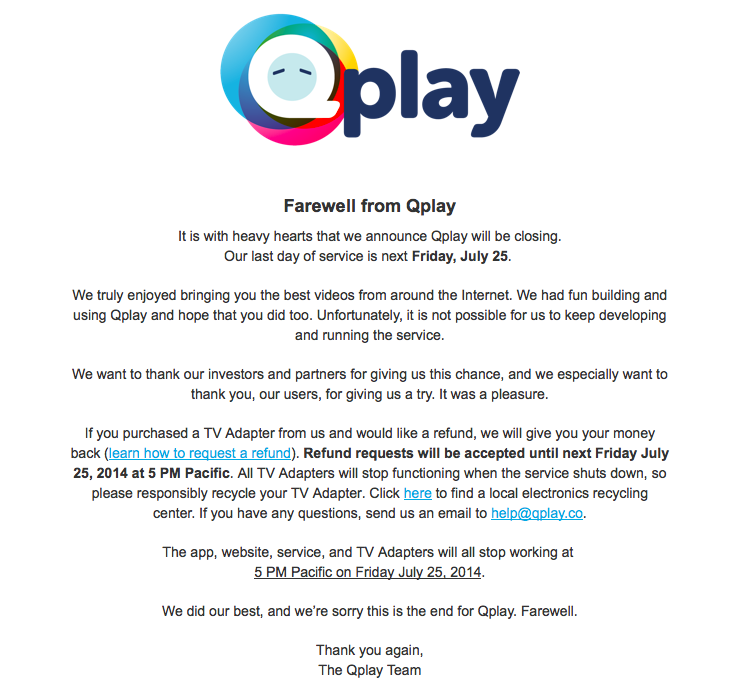Qplay seemed like it everything it needed to succeed. The small TV streaming adapter had Mike Ramsay and Jim Barton, the founders of the TiVo DVR set-top box, driving it. So it had a well-respected leadership team, a unique selling point and a raft of investors. What it didn’t have, however, is enough interest.
And so Qplay swallowed a big piece of humble pie on Saturday and announced its demise. After less than six months on the market, the service is shutting down on July 25.
Qplay offers several lessons for entrepreneurs and developers who think they’ve got “the next big thing” on their hands.

Lesson 1: Being Different’s Not Enough
See also: Lean Back: TiVo Founders Want Streaming TV To Come To You With Qplay
QPlay hit the market in February with a unique premise. The flat, brick-colored little box let people lean back and enjoy “Qs” (or queues) of videos based on user’s interests, populated by social networks or particular Qs they follow.
It could have been an enticing proposition for cord cutters who miss the experience of flipping on the boob tube and vegging out. Investors, like Redpoint Ventures and Kleiner Perkins Caufield & Byers, thought so too. But it didn’t take long for all involved to realize that things were going wrong.
The TV market is fickle, and new contenders hit the scene all the time. Despite the hype of smart TVs, options for streaming devices keeps growing.
Roku and Apple TV led the pack until last year, when Chromecast launched. This spring saw the introduction of Amazon Fire TV and just last month, Google announced Android TV would be heading to televisions and other streaming gadgets.
See also: Hello, TV Channels—And Hello, TV Apps
Being different just wouldn’t be enough—not when viewers are being told they can fling video to their large screens from their phones, or talk to their televisions to conjure or control videos. Against that backdrop, Qplay just couldn’t make vegging out all that exciting to consumers.
But with more time, some might have given it a chance. (For instance, the ability to sit back and relax in front of the TV is the primary reason my husband refuses to cut our cord.) Too bad that didn’t include app developers or any of the online video services people consider essential today.
Lesson 2: You Can’t Win At Streaming With Nothing To Stream

When you enter the shark-infested waters of TV streaming, you’ve got to make sure you have enough enough inventory to stay afloat. That’s where Qplay went wrong.
Customers who bought the little brick-colored device discovered quickly that, for their $49, they could only watch free online videos. Netflix was nowhere to be found, neither was Hulu or any other premium streaming service.
Even Chromecast, Google’s compact TV stick, supports both Netflix and Hulu, along with HBO GO and numerous other services and third-party apps. In fact, all the other major streaming devices offer premium online programming—including TiVo, the device previously conceived and founded by Qplay’s creators.
What did Qplay customers get? YouTube, Vimeo, Twitter, Facebook, Comedy Central, The New York Times and Yahoo. It didn’t even offer Plex, a popular indie service that lets users stream their own videos. And they’re practically everywhere.
It’s worth noting that Chromecast launched with even fewer streaming options—just four at launch, and only one from outside the company. But it was an important one: Netflix. And the gadget only costs $35, making it nearly an impulse purchase. The price point is likely the main reason it still sits at the top of Amazon’s bestselling electronics list, ahead of the e-commerce giant’s own Fire TV.
Lesson 3: If You’ve Got To Go, Leave With Dignity

Just last month, it looked like Qplay was on the road to development, having launched a new iPad app. The decision to shutter may seem sudden, but Qplay’s premise might have been flawed to begin with.
The company may have misread today’s streaming users, figuring they’d crave the same passive viewing that standard TV afforded. If that’s true, it would certainly be another nail in the coffin of the traditional television experience.
See also: Goodbye, TV Channels—And Hello, TV Apps
But Qplay will never know if it was on the right track or not. It just couldn’t line up the developers or streaming partners it needed to give this idea a fighting chance.
To its credit, the company is offering refunds to paying customers. It’s a classy move, one that many failing startups don’t (or can’t) make. In all likelihood, it probably means that Mike Ramsay and Jim Barton aren’t done yet. If they have something else cooking, they won’t want to burn any bridges with customers.
If they do, at least they’ll take away a few lessons from the Qplay experience. And hopefully, they won’t be passive about it.
Photos by Adriana Lee for ReadWrite. Screencap of iPad app courtesy of Qplay.










